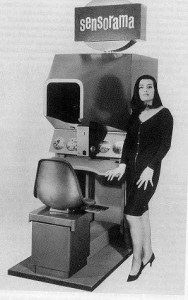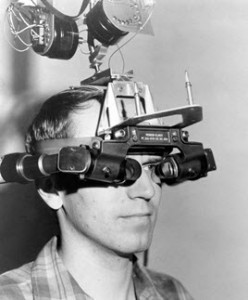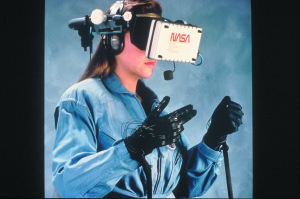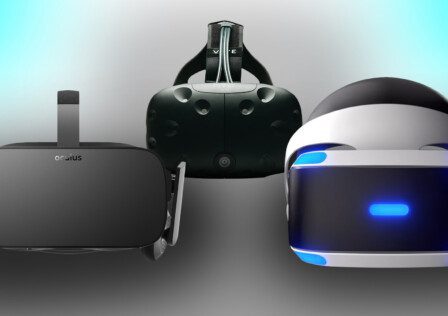The imminent arrival of the Oculus Rift has a lot of consumers salivating at the idea of some refreshingly new gaming experiences. It’s also kicked off a mini VR war amongst some of the biggest tech companies, with the likes of Sony and Samsung getting in on the action. So with virtual reality headsets being the latest ‘big thing’, we thought we’d have a look back at some of the Oculus Rift’s most significant ancestors.
Sensorama (1956)

Envisioned by Morton Heilig and described by its creator as an “Experience Theater”, the Sensorama wouldn’t have looked too out of place in a modern-day arcade. The idea was to combine on-screen stereoscopic 3D video with movement, and even timed odour release in order to draw in the user. Unfortunately, Heilig couldn’t get financial backing for his vision, and work on the Sensorama was halted. You never know though, maybe the team at Oculus will release a version of the Rift that incorporates some kind of ‘Smell Vision’ in memory of Heilig’s work.
Telesphere Mask (1960)
Heilig’s next attempt at a form of VR actually looked a little more like what we’re used to seeing today. Though it lacked any form of motion tracking, this headset provided stereoscopic 3D TV, wide vision and true stereo sound.
Headsight (1961)
In 1961, employees of the Philco Corporation constructed the first actual head-mounted display. Headsight consisted of a single CRT element attached to a helmet and a rudimentary magnetic tracking system to determine the direction of the head. The Headsight was primarily used for remotely viewing dangerous situations and so, like most new technologies, was utilised mainly by the military. There’s nothing quite like watching explosions up close and personal from the comfort of your own VR headset.
The Sword of Damocles (1968)

For many, the first virtual reality head-mounted display of its kind, the Sword of Damocles was named for its *cough* mildly intimidating appearance. Developed by computer scientist Ivan Sutherland in 1968, its users had to have their heads securely fastened into the device, which was attached to a mechanical arm suspended from the ceiling. This gave the impression of something more like a torture device than a VR headset, and led to the somewhat unusual name. We also can’t help but think that this design would also have gone some way to solving the issue of people falling over whilst using the Oculus for the first time.
Computer graphics being what they were at the time, the virtual environment created by the Sword of Damocles was no more than a simple wireframe room. The first display application was even more basic than that, consisting of a cube suspended in mid-air in front of the user. The display was also semi-translucent, which is also why the device is also considered one of the first augmented reality devices.
1968–1980
Throughout this period of time, work on virtual reality devices seemed to branch more towards gesture control. Various machines, from large mechanical arms, that allowed users to manipulate virtual objects, to projected keyboards with tactile feedback were developed. The Dataglove was a particularly famous creation, which has seen many iterations since its first version, the Sayre Glove, was developed by Electronic Visualization Laboratory in 1977. Datagloves have allowed programs to accurately track finger movements and hand gestures. One of the first wired gloves available to home users was actually the Nintendo Power Glove in 1987, and one of the first devices to bring gesture control to gaming.
NASA Ames VIEW or VIVID (1985)

The VIEW or Virtual Interface Environment Workstation combined a head-mounted display with datagloves. The user could see virtual versions of their own hands within a computer generated environment and were able to grasp and manipulate objects. What with how little we imagine those NASA scientists got out and the computer hardware at their disposal, one can only imagine the kinds of computer generated objects they were ‘manipulating’ behind closed doors.
1985–1990s
The major VR developments throughout the late ’80s and ’90s were in flight simulation. The USAF Super Cockpit (1985) and the British Aerospace Virtual Cockpit were the first examples of flight training simulators for pilots. They provided visual, auditory and tactile feedback as well as allowing head, eye, speech and hand input. Naturally though, these simulators were very, very big, and couldn’t be contained in a headset alone.
These large flight simulators, though primarily used by the military, eventually found their way into the entertainment industry. From these early contraptions came the 4D theatres and simulators that can be found at theme parks around the world. Not only that, but they led to the flight simulators we play on consoles and PCs today.
Virtual Boy (1995)

Last but not least, how can we forget the Virtual Boy. A 3D gaming console, marketed by Nintendo as a device that would “totally immerse players into their own private universe”, it was, in the end, a commercial failure and was never released outside of North America. Though in appearance it doesn’t seem too dissimilar to devices like the Oculus Rift and Project Morpheus, it was in fact its own ‘table-top’ console. Consisting of an eyepiece attached to the main body of the device and a controller with dual d-pads, it was mainly designed to be used whilst sat at a table or desk. Nintendo did claim it could be used whilst standing, and it was portable to an extent, with battery power available via a slide-on attachment.
Unfortunately, Nintendo’s library of games for the device was extremely limited and this was in no way helped by the fact that the display consisted exclusively of red LEDs. A colour display was too expensive at the time, with the initial asking price already a hefty $180. This put the Virtual Boy somewhere between the slightly more expensive consoles of the time, and the ever popular Game Boy. While in the end it proved to be a failed attempt at a new way of gaming, the Virtual Boy was definitely a good example of Nintendo’s focus on and reputation for innovation.
Today
So, in closing, virtual reality is by no means a new thing. It has been around in one form or another for over half a century – but has never really managed to break into the mainstream consumer market. Now though, with the current level of computer processing power available to anybody who owns a current-gen console or gaming PC, it may finally be time for VR to step up. Can the Oculus Rift and Sony’s Project Morpheus bring about a new era of gaming? The majority of gamers have probably dreamt about being able to step inside the games they’re playing and finally we are getting the chance to do that. If virtual reality is taken seriously and continues to get the funding it has seen over the last few years, there’s no saying where it might be in ten or 20 years’ time. You never know, maybe something like the Holodeck won’t always be a thing of science fiction.

